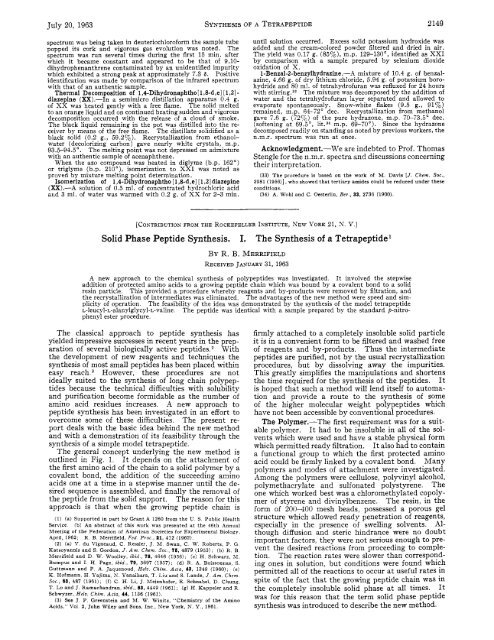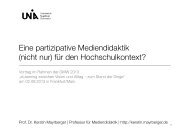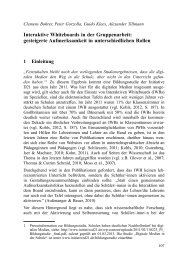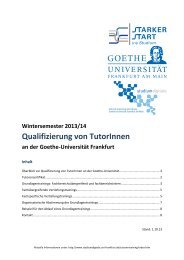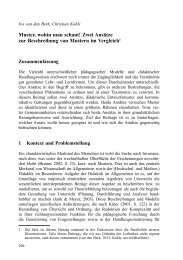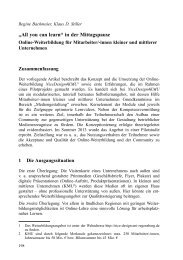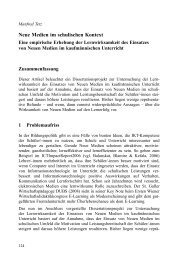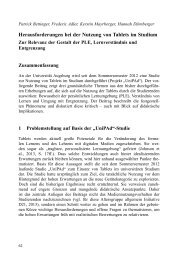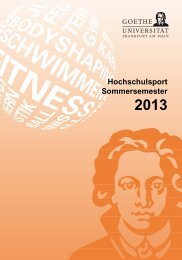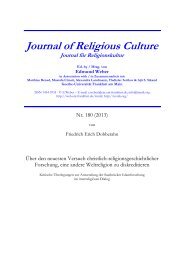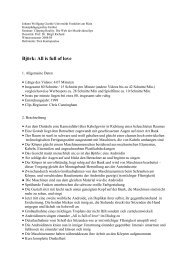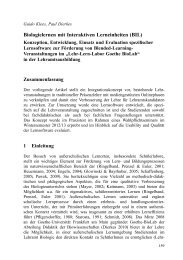Solid Phase Peptide Synthesis. I. The Synthesis of a Tetrapeptide'
Solid Phase Peptide Synthesis. I. The Synthesis of a Tetrapeptide'
Solid Phase Peptide Synthesis. I. The Synthesis of a Tetrapeptide'
You also want an ePaper? Increase the reach of your titles
YUMPU automatically turns print PDFs into web optimized ePapers that Google loves.
July 20, 1963 SYNTHESIS OF A TETRAPEPTIDE 2149<br />
spectrum was being taken in deuteriochlor<strong>of</strong>orm the sample tube<br />
popped its cork and vigorous gas evolution was noted. <strong>The</strong><br />
spectrum was run several times during the first 15 min. after<br />
which it became constant and appeared to be that <strong>of</strong> 9,10-<br />
dihydrophenanthrene contaminated by an unidentified impurity<br />
which exhibited a strong peak at approximately 7.3 6. Positive<br />
identification was made by comparison <strong>of</strong> the infrared spectrum<br />
with that <strong>of</strong> an authentic sample.<br />
<strong>The</strong>rmal Decomposition <strong>of</strong> 1,4-Dihydronaphtho[ 1,8-d,e] [ 1,2] -<br />
diazepine (=).-In a semimicro distillation apparatus 0.4 g.<br />
<strong>of</strong> XX was heated gently with a free flame. <strong>The</strong> solid melted<br />
to an orange liquid and on continued heating sudden and vigorous<br />
decomposition occurred with the release <strong>of</strong> a cloud <strong>of</strong> smoke.<br />
<strong>The</strong> black liquid remaining in the pot was distilled into the re-<br />
ceiver by means <strong>of</strong> the free flame. <strong>The</strong> distillate solidified as a<br />
black solid (0.2 g., 59.2%). Recrystallization from ethanol-<br />
water (decolorizing carbon) gave nearly white crystals, m.p.<br />
93.5-94.5". <strong>The</strong> melting point was not depressed on admixture<br />
with an authentic sample <strong>of</strong> acenaphthene.<br />
When the azo compound was heated in diglyme (b.p. 162")<br />
or triglyme (b.p. 210°), isomerization to XXI was noted as<br />
proved by mixture melting point determination.<br />
Isomerization <strong>of</strong> 1,4-Dihydronaphtho [ 1,8-d,e] [ 1 ,2] diazepine<br />
(=).-A solution <strong>of</strong> 0.5 ml. <strong>of</strong> concentrated hydrochloric acid<br />
and 3 ml. <strong>of</strong> water was warmed with 0.2 g. <strong>of</strong> XX for 2-3 min.<br />
until solution occurred. Excess solid potassium hydroxide was<br />
added and the cream-colored powder filtered and dried in air.<br />
<strong>The</strong> yield was 0.17 g. (85%), m.p. 129-130°, identified as XXI<br />
by comparison with a sample prepared by selenium dioxide<br />
oxidation <strong>of</strong> X.<br />
1-Benzal-2-benzylhydrazine.-A mixture <strong>of</strong> 10.4 g. <strong>of</strong> benzal-<br />
azine, 4.66 g. <strong>of</strong> dry lithium chloride, 5.94 g. <strong>of</strong> potassium boro-<br />
hydride and 80 ml. <strong>of</strong> tetrahydr<strong>of</strong>uran was refluxed for 24 hours<br />
with stirring.33 <strong>The</strong> mixture was decomposed by the addition <strong>of</strong><br />
water and the tetrahydr<strong>of</strong>uran layer separated and allowed to<br />
evaporate spontaneously. Snow-white flakes (9.5 g., 91%)<br />
remained, m.p. 64-72" dec. Recrystallization from methanol<br />
gave 7.6 g. (727') <strong>of</strong> the pure hydrazone, m.p. 70-73.5" dec.<br />
(s<strong>of</strong>tening at 69.5', lit.34 m.p. 69-70'). Since the hydrazone<br />
decomposed readily on standing as noted by previous workers, the<br />
n.m.r. spectrum was run at once.<br />
Acknowledgment.-We are indebted to Pr<strong>of</strong>. Thomas<br />
Stengle for the n.m.r. spectra and discussions concerning<br />
their interpretation.<br />
(33) <strong>The</strong> procedure is based on the work <strong>of</strong> M. Davis [J. Chem. Soc.,<br />
3981 (1956)], who showed that tertiary amides could be reduced under these<br />
conditions.<br />
(34) A. Wohl and C. Oesterlin, Ber., 33, 2736 (1900).<br />
[CONTRIBUTION FROM THE ROCKEFELLER INSTITUTE, XEW YORK 21, N. Y.]<br />
<strong>Solid</strong> <strong>Phase</strong> <strong>Peptide</strong> <strong>Synthesis</strong>. I. <strong>The</strong> <strong>Synthesis</strong> <strong>of</strong> a <strong>Tetrapeptide'</strong><br />
BY R. B. MERRIFIELD<br />
RECEIVED JANUARY 31, 1963<br />
A new approach to the chemical synthesis <strong>of</strong> polypeptides was investigated. It involved the stepwise<br />
addition <strong>of</strong> protected amino acids to a growing peptide chain which was bound by a covalent bond to a solid<br />
resin particle. This provided a procedure whereby reagents and by-products were removed by filtration, and<br />
the recrystallization <strong>of</strong> intermediates was eliminated. <strong>The</strong> advantages <strong>of</strong> the new method were speed and simplicity<br />
<strong>of</strong> operation. <strong>The</strong> feasibility <strong>of</strong> the idea was demonstrated by the synthesis <strong>of</strong> the model tetrapeptide<br />
L-leucyl-L-alanylglycyl-L-valine. <strong>The</strong> peptide was identical with a sample prepared by the standard p-nitrophenyl<br />
ester procedure.<br />
<strong>The</strong> classical approach to peptide synthesis has<br />
yielded impressive successes in recent years in the prep-<br />
aration <strong>of</strong> several biologically active peptides. * With<br />
the development <strong>of</strong> new reagents and techniques the<br />
synthesis <strong>of</strong> most small peptides has been placed within<br />
easy reach.3 However, these procedures are not<br />
ideally suited to the synthesis <strong>of</strong> long chain polypep-<br />
tides because the technical difficulties with solubility<br />
and purification become formidable as the number <strong>of</strong><br />
amino acid residues increases. A new approach to<br />
peptide synthesis has been investigated in an effort to<br />
overcome some <strong>of</strong> these difficulties. <strong>The</strong> present re-<br />
port deals with the basic idea behind the new method<br />
and with a demonstration <strong>of</strong> its feasibility through the<br />
synthesis <strong>of</strong> a simple model tetrapeptide.<br />
<strong>The</strong> general concept underlying the new method is<br />
outlined in Fig. 1. It depends on the attachment <strong>of</strong><br />
the first amino acid <strong>of</strong> the chain to a solid polymer by a<br />
covalent bond, the addition <strong>of</strong> the succeeding amino<br />
acids one at a time in a stepwise manner until the de-<br />
sired sequence is assembled, and finally the removal <strong>of</strong><br />
the peptide from the solid support. <strong>The</strong> reason for this<br />
approach is that when the growing peptide chain is<br />
(1) (a) Supported in part by Grant A 1260 from the U. S. Public Health<br />
Service (b) An abstract <strong>of</strong> this work was presented at the 46th Annual<br />
Meeting <strong>of</strong> the Federation <strong>of</strong> American Societies for Experimental Biology.<br />
April, 1962; R. B. Merrifield, Fad. Proc., 21, 412 (1962).<br />
(2) (a) V. du Vigneaud, C. Ressler, J. M Swan, C. W. Roberts, P. G.<br />
Katsoyannis and S. Gordon, J . Am. Chem. Soc., 75, 4879 (1953); (b) R. B.<br />
Merrifield and D. W. Woolley, ibid., 78, 4646 (1956); (c) H. Schwarz, M.<br />
Bumpus and I. H. Page, ibid., 79, 5697 (1957); (d) R. A. Boissonnas, S.<br />
Guttmann and P. A. Jaquenoud, Helu. Chim. Acto, 43, 1349 (1960); (e)<br />
K. H<strong>of</strong>mann, H. Yajima, S. Yanaihara, T. Liu and S. Lande, J . Am. Chem.<br />
Soc., 88, 487 (1961); (f) C. H. Li, J. Meienh<strong>of</strong>er, E. Schnabel, D. Chung,<br />
T. Lo and J. Ramachandran, ibid., 88, 4449 (1961); (9) H. Kappeler and R.<br />
Schwyzer, Xelv. Chim. Ada, 44, 1136 (1961).<br />
(3) See J. P. Greenstein and M. W. Winite, "Chemistry <strong>of</strong> the Amino<br />
Acids," Vol 2, John Wiley and Sons, Inc., New York, N. Y., 1961.<br />
firmly attached to a completely insoluble solid particle<br />
it is in a convenient form to be filtered and washed free<br />
<strong>of</strong> reagents and by-products. Thus the intermediate<br />
peptides are purified, not by the usual recrystallization<br />
procedures, but by dissolving away the impurities.<br />
This greatly simplifies the manipulations and shortens<br />
the time required for the synthesis <strong>of</strong> the peptides. It<br />
is hoped that such a method will lend itself to automa-<br />
tion and provide a route to the synthesis <strong>of</strong> some<br />
<strong>of</strong> the higher molecular weight polypeptides which<br />
have not been accessible by conventional procedures.<br />
<strong>The</strong> Polymer.-<strong>The</strong> first requirement was for a suit-<br />
able polymer. It had to be insoluble in all <strong>of</strong> the sol-<br />
vents which were used and have a stable physical form<br />
which permitted ready filtration. It also had to contain<br />
a functional group to which the first protected amino<br />
acid could be firmly linked by a covalent bond. Many<br />
polymers and modes <strong>of</strong> attachment were investigated.<br />
Among the polymers were cellulose, polyvinyl alcohol,<br />
polymethacrylate and sulfonated polystyrene. <strong>The</strong><br />
one which worked best was a chloromethylated copoly-<br />
mer <strong>of</strong> styrene and divinylbenzene. <strong>The</strong> resin, in the<br />
form <strong>of</strong> 200-400 mesh beads, possessed a porous gel<br />
structure which allowed ready penetration <strong>of</strong> reagents,<br />
especially in the presence <strong>of</strong> swelling solvents. AI-<br />
though diffusion and steric hindrance were no doubt<br />
important factors, they were not serious enough to pre-<br />
vent the desired reactions from proceeding to comple-<br />
tion. <strong>The</strong> reaction rates were slower than correspond-<br />
ing ones in solution, but conditions were found which<br />
permitted all <strong>of</strong> the reactions to occur at useful rates in<br />
spite <strong>of</strong> the fact that the growing peptide chain was in<br />
the completely insoluble solid phase at all times. It<br />
was for this reason that the term solid phase peptide<br />
synthesis was introduced to describe the new method.
2150 R. B. MERRIFIELD<br />
-2 NO<br />
C ICH2 -0 -Polystyrene<br />
I<br />
R 0 R 01 NO2<br />
1 2 1 1 I'll<br />
Cbzo -NHCHC- NH CHC 0 -C H 2'Q -Polystyrene<br />
I<br />
lNaoH<br />
720 BI fl<br />
NHzCHC- NHCHCOH<br />
Fig. 1.-<strong>The</strong> scheme for solid phase peptide synthesis.<br />
Attachment <strong>of</strong> the First Amino Acid to the Polymer.-<br />
To provide a point <strong>of</strong> attachment for the peptide the<br />
polystyrene resin was partially chloromethylated.4<br />
For reasons to be discussed later the product was then<br />
nitrated or brominated. <strong>The</strong> resulting substituted<br />
chloromethyl polystyrene was treated with the tri-<br />
ethylammonium salt <strong>of</strong> the first protected amino acid<br />
in the proposed peptide chain to give a substituted<br />
benzyl ester linkage. This was the stable covalent<br />
bond which held the growing peptide chain in the solid<br />
phase on the supporting resin. <strong>The</strong> reaction was<br />
shown to go to completion with carbobenzoxyglycine at<br />
refluxing temperatures in dry solvents such as ethyl<br />
acetate, benzene or dioxane giving carbobenzoxyglycyl<br />
polymer.6 It was also demonstrated to proceed with<br />
carbobenzoxy-t-valine and carbobenzoxynitro-L-argin-<br />
ine. Racemization <strong>of</strong> the C-terminal amino acid was<br />
not observed during the reaction. <strong>The</strong> quantity <strong>of</strong><br />
amino acid attached to the resin was purposely limited<br />
to approximately 0.5 mmole per gram <strong>of</strong> substituted<br />
polymer. To avoid undesired alkylations in subse-<br />
quent steps the unreacted chloromethyl groups were<br />
then esterified with an excess <strong>of</strong> triethylammonium<br />
acetate. Complete reaction was indicated by the fact<br />
that the product was nearly free <strong>of</strong> halogen.<br />
Cleavage <strong>of</strong> the Amino-Protecting Group.-<strong>The</strong><br />
protecting group which was used throughout the syn-<br />
theses to be reported was the carbobenzoxy group.<br />
It was selected because it could be removed readily and<br />
completely by hydrogen bromide in glacial acetic acid.6<br />
Since the latter reagent also attacked the benzyl ester<br />
at a slow rate the loss <strong>of</strong> peptide from the resin was a<br />
serious problem. <strong>The</strong> difficulty was largely overcome<br />
by nitration or bromination <strong>of</strong> the polymer after the<br />
(4) K. W. Pepper, H. M. Paisley and M. A. Young, J. Chem. Soc., 4097<br />
(1953)<br />
(5) <strong>The</strong> abbreviated name carbobenzoxyglycyl polymer was used to designate<br />
the compound in which carbobenzoxyglycine was bound in ester linkage<br />
to the aromatic rings <strong>of</strong> the styrene-divinylbenzene copolymer through<br />
hydroxymethyl side chains. <strong>The</strong> number <strong>of</strong> substituents per molecule <strong>of</strong><br />
polymer varied and the exact location on the ring or distribution among the<br />
rings was not known. <strong>The</strong> other polymer derivatives were named in an<br />
analogous manner.<br />
(6) I>. Ben-Ishai and A Berger, J . Org. Chem., 17, 1564 (1952).<br />
Vol. 85<br />
chloromethylation step. Table I shows that while the<br />
carbobenzoxy group cleaved rapidly from the unsubstituted<br />
carbobenzoxy-L-valyl polymer even in 10%<br />
HBr-acetic acid there was also considerable loss <strong>of</strong> ester.<br />
After nitration the rate <strong>of</strong> removal <strong>of</strong> carbobenzoxy<br />
was decreased, but the loss <strong>of</strong> ester was reduced<br />
to a very small level. With 30y0 HBr the carbobenzoxy<br />
group was removed in 2 to 4 hr., while the<br />
ester cleavage remained at a low level for at least 6 hr.<br />
In fact, the peptides could not be removed completely<br />
from the nitrated resin even with proloaged HBr treatment.<br />
<strong>The</strong> carbobenzoxy-L-valyl bromopolymer had<br />
properties intermediate between the nitrated and unsubstituted<br />
derivatives with respect to the stability <strong>of</strong><br />
the carbobenzoxy and ester bonds. <strong>The</strong> carbobenzoxy<br />
group could be removed from it with dilute (10%) HBr<br />
and the ester could be cleaved with concentrated (30%)<br />
HBr.<br />
Time,<br />
min ,<br />
5<br />
10<br />
20<br />
30<br />
60<br />
90<br />
120<br />
180<br />
240<br />
300<br />
TABLE I<br />
CLEAVAGE OF CARBOBENZOXY AND ESTER GROUPS BY<br />
HBr-ACETIC ACID<br />
----------Extent <strong>of</strong> cleavage, yo---------<br />
C bz- val-<br />
Cbz-Val Cbz-val- -bromopol ymer-<br />
-polymer- ------nitropolymer--- 30 %<br />
-10% HBr-. -10% HBr- -30% HBr- -10% HBr- HBr<br />
Cbz Ester Cbz Ester Cbz Ester Cbz Ester Ester<br />
52 6 8 0.5 8<br />
73 8 6 14 17 1.1 13<br />
90 12 12 28 32 2.2 21<br />
100 15 19 43 1.2 28<br />
100 18 38 1.2 67 77 6 46<br />
57 2.0 90 3.8 52<br />
67 2.5 100 4.3 87 10 58<br />
83 99 91 14<br />
94 3.2 108 5.4 69<br />
99 3.2 98 4.8 100 18<br />
<strong>The</strong> <strong>Peptide</strong>-Forming Step.-After removal <strong>of</strong> the N-<br />
terminal protecting group by HBr the hydrobromide<br />
was neutralized with excess triethylamine and the free<br />
base was coupled with the next protected amino acid.<br />
Although the p-nitrophenyl ester method' at first ap-<br />
peared to be ideal for this step it finally proved to be un-<br />
satisfactory after many experiments. <strong>The</strong> yields were<br />
not high enough even with elevated temperatures (80')<br />
and there was evidence for partial racemization (Table<br />
11). <strong>The</strong> N,N'-dicyclohexylcarbodiimide method,8 on<br />
the other hand, proved to be very satisfactory. <strong>The</strong><br />
reaction went in virtually quantitative yield in about<br />
30 minutes at room temperature. <strong>The</strong> relatively in-<br />
soluble by-product dicyclohexylurea and the rearrange-<br />
ment product carbobenzoxyaminoacyldicyclohexylurea,<br />
which was formed in appreciable quantities, were both<br />
easily removed by thorough washing. In conventional<br />
syntheses this is not always the case, especially when<br />
the peptide derivatives have become large and relatively<br />
insoluble themselves. <strong>The</strong> choice <strong>of</strong> solvent for the<br />
condensation was very important. Of the several sol-<br />
vents which were examined dimethylformamide was<br />
the best, methylene chloride was satisfactory, but<br />
dioxane, benzene, ethanol, pyridine and water gave very<br />
low yields and were not useful. <strong>The</strong> effectiveness <strong>of</strong><br />
the solvent depended partly on its ability to swell the<br />
resin and partly on other factors. For example, the<br />
two effective solvents (dimethylformamide and methyl-<br />
ene chloride) had high dielectric constants and also<br />
swelled the resin whereas benzene, which swelled the<br />
resin but had a low dielectric constant, was ineffective.<br />
<strong>The</strong> coupling reaction was shown to occur between<br />
glycylvalyl polymer and the carbobenzoxy derivatives<br />
(7) M. Bodanszky, Nalure, 171, 685 (1955).<br />
(8) J C Sheehan and G. P Hess, J. Am Chem Soc., 77, 1067 (1955).
July 20, 1963 SYNTHESIS OF A TETRAPEPTIDE 2151<br />
TABLE I1<br />
(1 <strong>The</strong> concentration <strong>of</strong> each amino acid in a leucine amino-<br />
peptidase digest divided by the corresponding value in a 6 N<br />
HCI hydrolysate.<br />
<strong>of</strong> leucine, isoleucine, valine, alanine, glycine, phenylalanine,<br />
0-benzyltyrosine, proline, serine, threonine,<br />
methionine, S-benzylcysteine, im-benzylhistidine, nitroarginine,<br />
y-methyl glutamate and asparagine. Lysine<br />
and tryptophan derivatives were not studied.<br />
Since it was very important that no unreacted amine<br />
remain after the peptide-forming reacti~n,~ several precautions<br />
were taken, First, an excess <strong>of</strong> carbobenzoxyamino<br />
acid and <strong>of</strong> diimide was used and each condensation<br />
step was repeated with fresh reagents.<br />
Finally, after the coupling reactions were completed<br />
any trace <strong>of</strong> unreacted amine was acetylated with a<br />
large excess <strong>of</strong> acetic anhydride and triethylamine.<br />
This reduced the free amine to less than 0.1% <strong>of</strong> that<br />
originally present. <strong>The</strong> acetamido bond was completely<br />
resistant to 30% HBr-acetic acid for 18 hours<br />
at 25'. Consequently, the danger <strong>of</strong> re-exposure <strong>of</strong><br />
these amino groups during subsequent steps was eliminated.<br />
<strong>The</strong> steps described to this point completed one cycle,<br />
i.e., the peptide chain was lengthened by one amino<br />
acid residue. Further cycles were carried out in the<br />
same way by alternately deprotecting and coupling with<br />
the appropriate carbobenzoxyamino acid. <strong>The</strong> completed<br />
protected peptides were finally decarbobenzoxylated<br />
by HBr and the free peptides were liberated from<br />
the polymer by saponification, or, in the case <strong>of</strong> the<br />
brominated resin, by more vigorous HBr treatment.<br />
<strong>The</strong> liberated peptides were desalted and purified by<br />
ion-exchange chromatography, countercurrent distribution<br />
or other suitable procedures.<br />
In order to establish the optimal conditions for the<br />
various reactions and to test the feasibility <strong>of</strong> the<br />
method as outlined, the simple tetrapeptide L-leucyl-Lalanylglycyl-L-valine<br />
was synthesized. Carbobenzoxy-<br />
L-leucyl-L-alanylglycyl-L-valyl polymer was made by<br />
the stepwise procedures described, using first the nitrophenyl<br />
ester method and later the more suitable diimide<br />
reaction. <strong>The</strong> latter was used on both nitrated and<br />
brominated polymer. <strong>The</strong> best procedure was with<br />
the nitropolymer using dicyclohexylcarbodiimide in<br />
dimethylformamide for the coupling reaction and<br />
saponification for the liberation <strong>of</strong> the free peptide.<br />
Isolation and Purification <strong>of</strong> the <strong>Peptide</strong>s.-<strong>The</strong><br />
crude peptide product liberated from the resin was<br />
chromatographed on a Dowex 50-X4 column using<br />
0.1 M pH 4.0 pyridine acetate buffer. <strong>The</strong> eluate was<br />
analyzed by the quantitative ninhydrin reaction <strong>of</strong><br />
Moore and Steinlo and by dry weight after evaporation<br />
<strong>of</strong> the volatile buffer from pooled fractions. Figure 2<br />
shows the chromatogram resulting from the separation<br />
<strong>of</strong> the peptides prepared on 10 g. <strong>of</strong> polymer. A total<br />
<strong>of</strong> 332 mg. <strong>of</strong> tetrapeptide was isolated which accounted<br />
for 80% <strong>of</strong> the free amino acids and peptides<br />
present in the crude product. In addition, an acetylated<br />
peptide fraction weighing 57 mg. passed through<br />
AMINO ACID ANALYSES OF L-LEUCYL-L-ALANYLGLYCYL-L-VALINE<br />
enzyme hydrolysate the column almost unretarded. It contained acetyl-<br />
Ratio'<br />
valine, acetylglycylvaline and acetyla!anylglycylval.ne<br />
Polymer Coupling Cleavage acid hydrolysate<br />
subst. method method Leu Ala Gly Val in approximately equal amounts. It was concluded<br />
NO, Active NaOH 0.83 0.73 0.61 0.58 that the coupling reactions were not quite quantitative,<br />
ester<br />
but that the unreacted amine was available to acetic<br />
NOz Diimide NaOH 1.00 1.05 0.97 . . anhydride and could be prevented from further reac-<br />
Br Diimide HBr 1.06 1.00 1.02 1.01 tions in this way. <strong>The</strong> presence <strong>of</strong> small amounts <strong>of</strong><br />
acetylated derivatives was not a serious difficulty,<br />
however, since these could be separated readily from<br />
the desired tetrapeptide. On the other hand, the<br />
presence <strong>of</strong> small amounts <strong>of</strong> the intermediate dipeptides<br />
(20 mg.) and tripeptides (33 mg.) was more<br />
serious and required the chromatographic separation<br />
for their removal from the tetrapeptide. <strong>The</strong>ir presence<br />
indicated that either the acetylation step, or more<br />
likely, the cleavage <strong>of</strong> the carbobenzoxy group was incomplete.<br />
Thus the appearance <strong>of</strong> leucylalanylvaline<br />
and leucylvaline must mean that some carbobenzoxyvaline<br />
remained after the first HBr-acetic acid treatment<br />
and was then deprotected by the second or third<br />
treatments. This could, <strong>of</strong> course, become serious if<br />
the synthesis <strong>of</strong> large polypeptides were contemplated.<br />
<strong>The</strong> presence <strong>of</strong> two peaks (at 1.25 1. and 1.34 1.) both<br />
containing leucine, alanine, glycine and valine also deserves<br />
some comment. <strong>The</strong> main component (92.5%)<br />
was shown by carboxypeptidase and leucine aminopeptidase<br />
digestions to be the desired all-L-peptide<br />
and the minor peak (7.5%) was found to be L-leucyl-Lalanylglycyl-D-valine.<br />
<strong>The</strong> explanation was clear when<br />
it was subsequently found that the sample <strong>of</strong> commercial<br />
carbobenzoxy-L-valine from which the peptides<br />
in this particular run were made contained 12% <strong>of</strong> carbobenzoxy-D-valine.<br />
<strong>The</strong> purity and identity <strong>of</strong> the tetrapeptide was established<br />
in the following ways: (1) Rechromatography<br />
on Dowex 50 gave a single homogeneous peak. (2)<br />
Countercurrent distribution" for 100 transfers gave a<br />
single symmetrical peak which agreed closely with the<br />
calculated theoretical curve. (3) Paper chromatography<br />
gave a single spot in three solvent systems.12 (4) <strong>The</strong><br />
ratios <strong>of</strong> amino acids determined by quantitative<br />
amino acid analysis13 <strong>of</strong> an acid hydrolysate were leucine<br />
1.00, alanine 1.00, glycine 0.99, valine 1.00. (a)<br />
Optical purity was demonstrated by digestion with<br />
two enzymes. Leucine aminopeptidase completely digested<br />
the peptide (Table 11). This showed the optical<br />
purity <strong>of</strong> L-leucine and L-alanine. Carboxypeptidase<br />
A completely liberated L-valine, demonstrating the<br />
optical purity <strong>of</strong> this amino acid. (6) <strong>The</strong> final pro<strong>of</strong><br />
was a comparison with the same tetrapeptide synthesized<br />
by conventional methods. <strong>The</strong> two peptides<br />
were identical by chromatography, optical rotation and<br />
infrared spectra.<br />
For the conventional synthesis the stepwise p-nitrophenyl<br />
ester method <strong>of</strong> Bodanszky' was used. L-<br />
Valine methyl ester was coupled with carbobenzoxyglycine<br />
p-nitrophenyl ester and the product hydrogenated<br />
to give glycyl-L-valine methyl ester which was<br />
condensed with carbobenzoxy-L-alanine p-nitrophenyl<br />
ester. <strong>The</strong> protected tripeptide was hydrogenated and<br />
coupled with carbobenzoxy-L-leucine p-nitrophenyl<br />
ester to give analytically pure carbobenzoxy-L-leucyl-<br />
(11) I,, C. Craig, J, D. Gregory and G. T. Barry, Cold Spring Harbor<br />
Symposia on Quanl. Biol., 14, 24 (1949).<br />
(12) <strong>The</strong> sprays used would have detected any impurities <strong>of</strong> free or pro..<br />
tected amino acids or peptides. <strong>The</strong> first was the ninhydrin spray, made by<br />
(9) If any amine remained unacylated after reaction with the carbobenz- dissolving 2 ml. <strong>of</strong> acetic acid, 3 ml. <strong>of</strong> pyridine and 200 mg. <strong>of</strong> ninhydrin in<br />
oxyamino acid it would be liable to react with the subsequent carbobenz- 100 ml. <strong>of</strong> acetone. <strong>The</strong> second was the hypochlorite-KI spray for amides;<br />
oxyamino acids. In this way a peptide chain lacking one or more <strong>of</strong> the in- see C. G. Greig and D. H. Leaback, Saluve, 188, 310 (1960), and R. H. Mazur,<br />
ternal amino acid residues would begin to grow. A family <strong>of</strong> closely related B. W. Ellis and P. S. Cammarata, J. Biol. Chem., 237, 1619 (1962).<br />
peptides, difficult to separate, would thus result.<br />
(13) S. Moore, D. H. Spackman and W. H. Stein, Anal. Chem., 30, 1185<br />
(10) S. Moore and W. H. Stein, J. Biol. Chem., 211, 907 (1954).<br />
(1958).
2152 R. B. MERRIFIELD Vol. 85<br />
L-alanylglycyl-L-valine methyl ester. Carbobenzoxy-<br />
L-leucyl-L-alanylglycyl-L-valine was also obtained analytically<br />
pure after saponification <strong>of</strong> the methyl ester.<br />
Catalytic hydrogenation over palladium-on-carbon<br />
gave the free tetrapeptide L-leucyl-L-alanylglycyl-Lvaline.<br />
<strong>The</strong>se experiments demonstrate the feasibility <strong>of</strong><br />
solid phase peptide synthesis. For the new method to<br />
be <strong>of</strong> real value it must, <strong>of</strong> course, be applied to the<br />
synthesis <strong>of</strong> much larger peptides, preferably to those<br />
with biological activity. It must also be automated if<br />
large polypeptides <strong>of</strong> predetermined sequence are to be<br />
made. Encouraging experiments along these lines are<br />
now under way.<br />
Experimental<br />
<strong>The</strong> Polymer.-Copolymers <strong>of</strong> styrene and divinylbenzene <strong>of</strong><br />
varying degrees <strong>of</strong> cross linking were obtained from the Dow<br />
Chemical C0.I4 <strong>The</strong> preparations were in the form <strong>of</strong> 200-400<br />
mesh beads. <strong>The</strong> degree <strong>of</strong> cross linking determined the extent<br />
<strong>of</strong> swelling, the effective pore size and the mechanical stability <strong>of</strong><br />
the beads, and these properties in turn determined the suitability<br />
<strong>of</strong> the polymers for peptide synthesis. <strong>The</strong> lyO cross-linked<br />
beads were somewhat too fragile and became disrupted during the<br />
peptide synthesis to an extent which made filtration difficult.<br />
On the other hand, the 8 and l6y0 cross-linked beads were too<br />
rigid to permit easy penetration <strong>of</strong> reagents, causing slower and<br />
less complete reactions. <strong>The</strong> 270 cross-linked resin was most<br />
useful and was employed for all the reactions reported here.<br />
<strong>The</strong> commercial product was washed thoroughly with A4 NaOH,<br />
M HC1, HzO, diyethylformamide and methanol and dried under<br />
vacuum at 100 . <strong>The</strong> resulting material consisted <strong>of</strong> nearly<br />
white spheres ranging from approximately 20 to 80 1.1 in diameter.<br />
Xo attempt was made to obtain particles <strong>of</strong> more uniform size.<br />
Chloromethylpolymer.4-Copolystyrene-27, divinylbenzene<br />
(50 g.) was swelled by stirring at 25' for 1 hr. in 300 ml. <strong>of</strong> chloro-<br />
form and then cooled to 0". A cold solution <strong>of</strong> 7.5 ml. <strong>of</strong> anhy-<br />
drous SnCL in 50 ml. <strong>of</strong> chloromethyl methyl ether was added and<br />
stirred for 30 min. at 0'. <strong>The</strong> mixture was filtered and washed<br />
with 11. <strong>of</strong> 3: 1 dioxane-water, and then with 1 1. <strong>of</strong> 3:l dioxane-3<br />
N HC1. <strong>The</strong> cream-colored beads were washed further with a<br />
solution which changed gradually from water to pure dioxane<br />
and then progressively to 1007, methanol. Abrupt changes <strong>of</strong><br />
solvent composition were avoided. <strong>The</strong> product was dried<br />
under vacuum at 100'; yield 55.0 g. <strong>The</strong> product contained 1.89<br />
mmoles <strong>of</strong> Cl/g., from which it could be calculated that approxi-<br />
mately 22'7, <strong>of</strong> the aromatic rings <strong>of</strong> the polymer were chloro-<br />
methylated. Conditions which would give this degree <strong>of</strong> substi-<br />
tution were purposely selected in order to minimize cross linking<br />
and to avoid starting peptide chains at the more difficultly<br />
accessible sites.<br />
Nitrochloromethylpo1ymer.-A 50-g. sample <strong>of</strong> the dry chloro-<br />
methylpolymer (1.89 mmole <strong>of</strong> Cl/g.) was added slowly with<br />
stirring to 500 ml. <strong>of</strong> fuming nitric acid (9070 HiYO?, sp. gr. 1.5)<br />
which had been cooled to 0". <strong>The</strong> mixture was stirred 1 hr. at<br />
0" and then poured into crushed ice. <strong>The</strong> light tan beads were<br />
filtered and washed as described above with water, dioxane and<br />
methanol and dried; yield 69.9 g. <strong>The</strong> nitrogen content was<br />
6.38 mmoles/g. by Dumas analysis. This was equivalent to<br />
1.03 nitro groups per aromatic ring.<br />
Bromochloromethylpolymer.-An 8.00-g. sample <strong>of</strong> chloro-<br />
methylpolymer (4.92 mmoles <strong>of</strong> Cl/g.) was suspended in 25 ml.<br />
<strong>of</strong> carbon tetrachloride containing 100 mg. <strong>of</strong> iodine. A solution<br />
<strong>of</strong> 5 ml. <strong>of</strong> bromine in 10 ml. <strong>of</strong> CCla was added and the mixture<br />
was stirred for 3 days in the dark at 25'. <strong>The</strong> deep red suspension<br />
was filtered and the polymer was washed with CCL, dioxane,<br />
water, sodium bicarbonate, water and methanol and dried;<br />
yield 12.5 g. <strong>The</strong> extent <strong>of</strong> substitution was 4.56 mmoles <strong>of</strong><br />
Br/g., which was equivalent to 0.97 bromine atom per aromatic<br />
ring.<br />
<strong>The</strong> Esterification Step. Carbobenzoxy-L-valyl Nitropolymer.<br />
--A solution <strong>of</strong> 15.5 g. (61.7 mmoles) <strong>of</strong> carbobenzoxy-L-valine<br />
and 8.65 ml. (61.7 mmoles) <strong>of</strong> triethylamine in 350 ml. <strong>of</strong> ethyl<br />
acetate was added to 40.0 g. <strong>of</strong> chloromethylnitropolymer and<br />
the mixture was stirred under reflux. After 48 hr., a solution <strong>of</strong><br />
12 ml. <strong>of</strong> acetic acid and 28 ml. <strong>of</strong> triethylamine in 100 ml. <strong>of</strong><br />
ethyl acetate was added and the stirring and heating continued<br />
for another 4 hr. <strong>The</strong> resin was filtered and washed thoroughly<br />
with ethyl acetate, ethanol, water and methanol by gradual<br />
change <strong>of</strong> solvent composition and dried under vacuum; yield<br />
46.9 g. A 30-mg. sample <strong>of</strong> the resulting esterified resin was<br />
hydrolyzed by refluxing for 24 hr. in a mixture <strong>of</strong> 5 ml. <strong>of</strong> acetic<br />
acid and 5 ml. <strong>of</strong> 6 ,V HC1. Valine in the filtrate was determined<br />
(14) Obtained from the Technical Service and Development Dept. <strong>of</strong> the<br />
Dow Chemical Co , Midland, Mich.<br />
by the ninhydrin method and found to be 0.56 mmole/g. A<br />
chlorine determination (Parr fusion) indicated that only 0.08<br />
mmole <strong>of</strong> Cl/g. remained. When carbobenzoxynitro-L-arginine<br />
was used in the corresponding reaction, ethyl acetate was replaced<br />
by dioxane as solvent because <strong>of</strong> the increased solubility<br />
<strong>of</strong> the triethylammonium salt.<br />
<strong>The</strong> Reaction Vessel.-A reaction vessel was designed to make<br />
possible the process <strong>of</strong> automatic synthesis. <strong>The</strong> remaining<br />
reactions to be described were conducted within this vessel. It<br />
consisted <strong>of</strong> a 45 X 125 mm. glass cylinder, sealed at one end and<br />
fitted with a 40-mm. medium porosity fritted disk filter at the<br />
other end. Immediately beyond the disk the tubing was constricted<br />
sharply and sealed to a 1.5-mm. bore stopcock through<br />
which solvents could be removed under suction. A side arm,<br />
fitted with a drying tube, was used to introduce reagents and to<br />
remove solid samples for analysis. <strong>The</strong> apparatus was attached<br />
to a mechanical rocker which rotated the vessel 90" between the<br />
vertical and horizontal positions and provided gentle but efficient<br />
mixing <strong>of</strong> solvents and polymer. At the end <strong>of</strong> each reaction the<br />
vessel was stopped in the vertical position with the fritted disk<br />
at the bottom so that opening the stopcock allowed the solvents<br />
to be removed by suction.<br />
<strong>The</strong> Deprotection Step. L-Valyl Nitropolymer.-Carbobenzoxy-L-valyl<br />
nitropolymer (10 g., 5.6 mmoles <strong>of</strong> valine) was introduced<br />
into the reaction vessel and 30 ml. <strong>of</strong> 30% HBr in acetic<br />
acid was added. After shaking for 5 hr. at 25', the suspension<br />
was diluted with 50 ml. <strong>of</strong> acetic acid, filtered and washed with<br />
acetic acid, ethanol and dimethylformamide (DMF). <strong>The</strong> resulting<br />
hydrobromide was then neutralized by shaking for 10<br />
min. in 30 ml. <strong>of</strong> DMF containing 3 ml. <strong>of</strong> triethylamine. <strong>The</strong><br />
solvent containing the triethylammonium bromide was removed<br />
by suction and the polymer was washed with DMF. <strong>The</strong> filtrate<br />
contained 5.4 mmoles <strong>of</strong> halogen (Volhard titration), indicating<br />
a quantitative removal <strong>of</strong> the carbobenzoxy group.<br />
<strong>The</strong> time required for the deprotection step was determined in<br />
two ways. In the first method 100-mg. samples <strong>of</strong> carbobenzoxy-t-valyl<br />
polymers (either nitrated, brominated or unsubstituted)<br />
were treated with 1 ml. <strong>of</strong> 10% or 30% HBr-HOAc. At<br />
intervals the samples were filtered and washed with acetic acid,<br />
ethanol and water. <strong>The</strong> resulting valyl polymer hydrobromides<br />
were then analyzed for halogen by Volhard titration. A measure<br />
<strong>of</strong> the rate <strong>of</strong> ester cleavage during the reaction was obtained by<br />
analyzing the filtrates for valine by the ninhydrin reaction.'"<br />
<strong>The</strong>se data are summarized in Table I. Completion <strong>of</strong> the<br />
reaction with 30% HBr-HOAc on carbobenzoxy-L-valyl nitropolymer<br />
required about 2 hr. and resulted in a loss <strong>of</strong> 4.3%. <strong>of</strong><br />
valine. <strong>The</strong> second determination <strong>of</strong> the rate <strong>of</strong> the reaction<br />
depended on coupling the free a-amino derivatives with another<br />
carbobenzoxyamino acid according to the procedures to be described<br />
below. <strong>The</strong> amount <strong>of</strong> the new amino acid thus added to<br />
the peptide was determined by hydrolysis and quantitative<br />
measurement <strong>of</strong> the amino acids. For this purpose the tripeptide<br />
derivative carbobenzoxy-L-alanylglycyl-L-Val yl nitropolymer<br />
was used and carbobenzoxy-L-leucine was coupled to it. <strong>The</strong><br />
leucine in the resulting tetrapeptide derivative was found to be<br />
0.05 mmole/g. for the 0.5-hr. deprotection time. For times <strong>of</strong><br />
2, 4 and 6 hr., the leucine values were 0.14, 0.31 and 0.29 m-<br />
mole/g. <strong>The</strong>se results showed that removal <strong>of</strong> the carbobenzoxy<br />
group was maximal under these conditions within 4 hr. In order<br />
to ensure a complete reaction at this step a standard time <strong>of</strong> 5 hr.<br />
was adopted.<br />
<strong>The</strong> <strong>Peptide</strong>-Forming Step. Carbobenzoxyglycyl-L-vdyl Nitropolymer.<br />
A. <strong>The</strong> Diimide Method.-Carbobenzoxy-L-valyl<br />
nitropolymer (10 g., 5.6 mmoles <strong>of</strong> valine) was deprotected and<br />
neutralized as described above. Immediately thereafter a sohtion<br />
containing 2.34 g. (11.2 mmoles) <strong>of</strong> carbobenzoxyglycine in<br />
20 ml. <strong>of</strong> dimethylformamide was added and shaken for 10 min.<br />
to allow for penetration <strong>of</strong> the reactant into the solid. A solution<br />
<strong>of</strong> 2.31 g. (11.2 mmoles) <strong>of</strong> dicyclohexylcarbodiimide in 4.6 ml.<br />
<strong>of</strong> DMF was then added and the suspension was shaken for 18<br />
hr. at 25". <strong>The</strong> polymer beads were sucked dry, washed with<br />
DMF, and an additional portion (1.17 9.) <strong>of</strong> carbobenzoxyglyclne<br />
in 20 ml. <strong>of</strong> DMF was added. After 10 min., 1.16 g. <strong>of</strong> dicyclohexylcarbodiimide<br />
was added, the mixture was shaken for 2 hr.<br />
and then filtered and washed. A solution <strong>of</strong> 3 ml. <strong>of</strong> acetic<br />
anhydride and 1 ml. <strong>of</strong> triethylamine in 20 ml. <strong>of</strong> DMF was then<br />
added. After 2 hr., the resin was filtered and washed four times<br />
each with DMF, ethanol and acetic acid to remove excess reagents<br />
and by-products. Although dicyclohexylurea is a relatively<br />
insoluble compound, it was readily removed in this<br />
manner (solubility about 4, 10 and 17 mg./ml. respectively, in<br />
DMF, ethanol and acetic acid). A hydrolysate <strong>of</strong> a dried sample<br />
<strong>of</strong> the product showed glycine 0.53 mmole/g. and valine 0.53<br />
mmole/g.<br />
<strong>The</strong> reaction time allowed for the peptide-forming step could<br />
probably be reduced to much less than the 18 hr. employed here,<br />
although the exact reaction rate will depend on the particular<br />
amino acid derivative, the length <strong>of</strong> the peptide chain and perhaps<br />
other factors. To determine the approximate rate <strong>of</strong> the coupling
July 20, 1963<br />
reaction, glycyl-~-valyl nitropolymer was condensed as just<br />
described with a tw<strong>of</strong>old excess <strong>of</strong> carbobenzoxy-L-alanine and<br />
dicyclohexylcarbodiimide in DMF. Portions <strong>of</strong> the suspension<br />
were removed at intervals, filtered, washed and dried. Weighed<br />
samples were hydrolyzed in 6 N HC1-acetic acid and analyzed<br />
quantitatively for amino acids by column chromatography.la<br />
Alanine was found to be 0.1, 0.2 and 0.4 mmole/g. after coupling<br />
times <strong>of</strong> 5, 10 and 30 min., and remained at this level up to 18 hr.<br />
B. <strong>The</strong> Nitrophenyl Ester Method.-A solution <strong>of</strong> 3.70 g.<br />
(1 1.2 mmoles) <strong>of</strong> carbobenzoxyglycine p-nitrophenyl ester in 30<br />
ml. <strong>of</strong> benzene was added to 10 g. <strong>of</strong> L-valyl nitropolymer hydrobromide<br />
(5.6 mmoles <strong>of</strong> valine) and stirred 1 hr. at 25" to allow<br />
swelling <strong>of</strong> the resin and penetration <strong>of</strong> the reagent. <strong>The</strong> swelling<br />
step was particularly important in order to get a satisfactory yield<br />
in this reaction. A solution <strong>of</strong> 5 ml. <strong>of</strong> triethylamine in 15 ml. :f<br />
benzene was added and the mixture was stirred for 18 hr. at 80 .<br />
<strong>The</strong> mixture was cooled, 3 ml. <strong>of</strong> acetic anhydride was added, and<br />
the mixture was stirred for 2 hr. at 25'. <strong>The</strong> product was then<br />
filtered, washed with benzene, ethanol, water, and methanol and<br />
dried. A hydrolysate showed glycine 0.29 mmole/g., and valine<br />
0.43 mmole/g.<br />
<strong>The</strong> effectiveness <strong>of</strong> the acetylation step in blocking free 0-<br />
amino groups was demonstrated in the following way. Samples<br />
(100 mg.) <strong>of</strong> L-valyl nitropolymer were stirred with acetic anhydride<br />
(0.3 ml.) and triethylayine (0.1 ml.) in DMF (2 ml.)<br />
for various lengths <strong>of</strong> time at 25 . <strong>The</strong> products were filtered,<br />
washed, and then saponified in ethanol (1 ml.) and 2 N NaOH<br />
(0.3 ml.) at 25" for 2 hr. Free valine was determined in the<br />
filtrate by the ninhydrin reaction <strong>The</strong> unacetylated control<br />
contained 0.72 mmole/g., while the 1.5-hr. and 24-hr. acetylation<br />
samples each contained only 0.0029 mmole/g.<br />
<strong>The</strong> stability <strong>of</strong> the acetylated product to HBr-HOAc was<br />
determined by treating samples (100 mg.) with 3070 HBr-HOAc<br />
(0.4 ml.) at 25" for 1 to 24 hr. <strong>The</strong> samples were then saponified<br />
as before and analyzed for free valine. In this experiment the<br />
untreated control showed 0.0015 mmole/g. and the 24-hr. sample<br />
0.0015 mmole/g.<br />
Carbobenzoxy-L-leucyl-L-alanylglycyl-L-valyl Nitropolymer.-<br />
<strong>The</strong> peptide chains were extended in a manner exactly analogous<br />
to the general procedures just described for the dipeptides.<br />
Carbobenzoxy-glycyl-L-valyl nitropolymer (from part A above),<br />
still in the reaction vessel, was treated with HBr-HOAc, neutralized<br />
with triethylamine and coupled with carbobenzoxy-Lalanine<br />
to give the tripeptide derivative. Without further<br />
manipulations another cycle was carried out using carbobenzoxy-<br />
L-leucine to give the desired tetrapeptide derivative. <strong>The</strong> same<br />
protected tetrapeptide polymer was also made by the nitrophenyl<br />
ester method.<br />
<strong>The</strong> <strong>Peptide</strong> Liberation Step. L-Leucyl-L-alanylglycyl-L-<br />
valine .-<strong>The</strong> carbobenzoxy-~-leucyl-~-alanylglycyl-~-valyl nitro-<br />
polymer described above was decarbobenzoxylated with HBr-<br />
HOAc in the usual way. It was then saponified by shaking for<br />
1 hr. at 25" in a solution <strong>of</strong> 40.5 ml. <strong>of</strong> ethanol and 4.5 ml. <strong>of</strong><br />
2 N aqueous NaOH. <strong>The</strong> filtrate, withdrawn through the fritted<br />
disk <strong>of</strong> the reaction vessel by suction, was neutralized at once with<br />
HCI and the saponification step was repeated on the resin with<br />
more ethanolic sodium hydroxide for another hour. <strong>The</strong> resin<br />
was washed with ethanol and water and the neutralized filtrates<br />
were combined. Quantitative ninhydrin analysis <strong>of</strong> the filtrate<br />
gave a total <strong>of</strong> 1.98 mmoles (leucine equivalents) and analysis <strong>of</strong><br />
an acid hydrolysate gave 6.92 mmoles. <strong>The</strong> ratio <strong>of</strong> 3.49 instead<br />
<strong>of</strong> the 4.0 expected for a tetrapeptide indicated that some amino<br />
acids or shorter chain peptides were also present. Since the<br />
ninhydrin value <strong>of</strong> an acid hydrolysate <strong>of</strong> the carbobenzoxy tetra-<br />
peptide polymer before saponification was 12.8 mmoles, the yield<br />
in the saponification step was 54%.<br />
<strong>The</strong> tetrapeptide was purified and isolated by ion-exchange<br />
chromatography on a 2 X 120 cm. column <strong>of</strong> Dowex 50-X4<br />
(200-400 mesh) resin using 0.1 M pH 4 pyridine acetate buffer.<br />
It was eluted at 1 ml./min. and collected in 5.4-ml. fractions.<br />
Aliquots (0.2 ml.) <strong>of</strong> the fractions were analyzed by the nin-<br />
hydrin method. Tubes comprising the peaks were pooled and<br />
their contents were weighed after evaporation <strong>of</strong> the buffer.<br />
<strong>The</strong> fractions were identified by paper chromatography <strong>of</strong> their<br />
acid hydrolysates. <strong>The</strong> results are summarized in Fig. 2. <strong>The</strong><br />
acetylated peptides emerged after only slight retardation as a<br />
group <strong>of</strong> four poorly resolved fractions. <strong>The</strong>y were thus easily<br />
and completely separated from the desired tetrapeptide which<br />
emerged at 1.25 1. <strong>The</strong> portion <strong>of</strong> the fraction between 1.12 and<br />
1.29 1. was combined, evaporated to dryness, dissolved in 20 ml.<br />
<strong>of</strong> ethanol, filtered and precipitated with 100 ml. <strong>of</strong> dry ether.<br />
<strong>The</strong> product was centrifuged, washed, and dried under vacuum<br />
at 60'. <strong>The</strong> yield was 265 mg. <strong>of</strong> a cream-colored, hygroscopic<br />
powder. Rechromatography on the same column gave a single<br />
sharp peak at 1.20 I. which indicated that ~-leucyl-~-alanylglycyl-<br />
D-valine had been completely removed.<br />
A 200-mg. sample <strong>of</strong> the tetrapeptide was countercurrented<br />
for 100 transfers in a solvent (10 ml. each phase) made from 2000<br />
ml. <strong>of</strong> redistilled sec-butyl alcohol, 22.2 ml. <strong>of</strong> glacial acetic acid<br />
SYNTHESIS OF A TETRAPEPTIDE 2153<br />
20[<br />
o 025 o.so 0.i~ 1.00 1.15 LSO I.i5<br />
Effluent volume (L,).<br />
Fig. 2.-Chromatographic separation <strong>of</strong> the tetrapeptide<br />
~-leucyl-~-alanylglycl-~-valine on a 2 X 120 cm. column <strong>of</strong> Dowex<br />
50-X4 resin. Elution was with 0.1 Mpyridine acetate buffer, pH<br />
4.0. <strong>The</strong> concentration was calculated from the ninhydrin analysis<br />
<strong>of</strong> individual tubes and dry weight <strong>of</strong> pooled fractions.<br />
and 1977 ml. <strong>of</strong> doubly distilled water. A single symmetrical<br />
peak resulted which was located by ninhydrin analysis on 0.2-ml.<br />
aliquots <strong>of</strong> both phases. <strong>The</strong> distribution coefficient was 0.32<br />
and was constant between tubes 16 and 33. This fraction was<br />
combined and evaporated to dryness; yield 195 mg. <strong>The</strong> peptide<br />
was dissolved in 2 ml. <strong>of</strong> ethanol and crystallized by the addition<br />
<strong>of</strong> 5 ml. <strong>of</strong> dioxane; yield 76 mg., [alZ1~ +18.0' (c 2, ethanol);<br />
Rr 0.71 (propanol-HnO, 2: l), 0.73 (sec-BuOH-formic acid),"<br />
0.49 (sec-B~OH-ammonia)'~; amino acid ratiosL3: leucine 1 .OO,<br />
alanine 1.00, glycine 0.99, valine 1 .OO.<br />
AnaZ.'B Calcd. for C16H30N405: C, 53.6; H, 8.4; N, 15.6.<br />
Found: C, 52.6; H, 8.2; N, 15.2.<br />
Optical Purity <strong>of</strong> the <strong>Peptide</strong>s.-<strong>The</strong> possibility <strong>of</strong> racemization<br />
<strong>of</strong> the leucine and alanine residues was examined with use <strong>of</strong><br />
leucine aminopeptidase (LAP) by a method similar to that described<br />
by H~fmann.'~ <strong>The</strong> peptide was incubated with'Worthington<br />
LAP (1 mg./20 mg. <strong>of</strong> peptide) for 2 days at 37 . <strong>The</strong><br />
digest was analyzed on a quantitative amino acid column and a<br />
comparison <strong>of</strong> the ratios <strong>of</strong> amino acids found after enzymatic<br />
hydrolysis to those found after acid hydrolysis was used as a<br />
measure <strong>of</strong> racemization (Table 11). Within the experimental<br />
error <strong>of</strong> about 5% it was found that the diimide method caused<br />
no racemization in the synthesis <strong>of</strong> the tetrapeptide. On the<br />
other hand, the nitrophenyl ester procedure gave a product containing<br />
approximately 17% <strong>of</strong> D-leucine and l2YO <strong>of</strong> malanine.<br />
Because the tetrapeptide isolated from the diimide route showed<br />
no evidence <strong>of</strong> racemized residues and because 92.57, <strong>of</strong> the total<br />
tetrapeptides in the reaction mixture was isolated as pure product,<br />
it was clear that racemization was not a problem with synthesis<br />
by the diimide method.<br />
<strong>The</strong> configuration <strong>of</strong> valine was established by carboxypeptidase<br />
digestion using Worthington carboxypeptidase A.'* In this<br />
case, hydrolysis was followed by paper chromatography in secbutyl<br />
alcohol-ammonia.15 <strong>The</strong> spot for tetrapeptide (Rr 0.49)<br />
progressively decreased while spots for valine (Rf 0.29) and leucylalanylglycine<br />
(R, 0.33) increased. After 3 hr., the reaction was<br />
essentially complete and the total ninhydrin value had doubled,<br />
indicating that the glycylvaline bond was completely digested<br />
and therefore that the valine had not been racemized. <strong>The</strong><br />
second tetrapeptide isolated from this run (peak at 1.34 1.) which<br />
represented 7.5% <strong>of</strong> the total was resistant to carboxypeptidase.<br />
After 20 hr. only unchanged tetrapeptide (Rf 0.49) was present.<br />
It therefore contained D-valine. This was presumed to have<br />
originated from the commercial carbobenzoxyvaline used as<br />
starting material in this run since the latter was subsequently<br />
shown to be 12'3, racemized.<br />
(15) W. Hausmann, J. Am. Ckem. Soc., 74, 3181 (1952).<br />
(16) <strong>The</strong> several samples <strong>of</strong> ~.-Ieucyl-L-alanylglycyl-~-valine prepared both<br />
by the new method and by the conventional procedure have, in every case,<br />
given analytical values for C, H and N which were a few per cent lower than<br />
theory. <strong>The</strong> data for the different preparations, however, havealwaysagreed<br />
well with one another. <strong>The</strong> values given were for samples dried for 18 hr.<br />
at looo under vacuum over PtOa. Other conditions were tried but did<br />
not change the results.<br />
(17) K. H<strong>of</strong>mann and H. Yajima, J. Am. Ckem. Soc., 85, 2289 (1961).<br />
(18) H. Neurath, E. Elkins and S. Kaufman, J. Bid. Chem., 170, 221<br />
(1947).
2154 SIDNEY BELMAN VOl. 85<br />
Conventional <strong>Synthesis</strong> <strong>of</strong> the Tetrapeptide. A. Carbobenz-<br />
oxyglycyl-L-valine Methyl Ester.-To 7.13 g. (0.0425 mole) <strong>of</strong><br />
L-valine methyl ester hydrochloride in 30 ml. <strong>of</strong> methylene chlo-<br />
ride at 0" was added 12 ml. (0.085mole) <strong>of</strong> triethylamine, followed<br />
by a solution <strong>of</strong> 14 g. (0.042 mole) <strong>of</strong> carbobenzoxyglycine p-<br />
nitrophenyl ester in 50 ml. <strong>of</strong> methylene chloride. After stand-<br />
ing 24 hr. at room temperature the clear yellow solution was<br />
washed with N ammonium hydroxide until colorless, then with N<br />
hydrochloric acid and water. <strong>The</strong> dried product was an oil<br />
weighing 10.3 g. (75%). Thin layer chromatography on silicic<br />
acid in chlor<strong>of</strong>orm-acetone (10: 1) gave one spot, Rr 0.75, by the<br />
hypochlorite-KI spray for amides.12 <strong>The</strong> oil was used directly<br />
for the next step.<br />
B . Carbobenzoxy-L-leucyl-L-alanylglycyl-L-valine Methyl<br />
Ester.-Carbobenzoxy-glycyl-L-valine methyl ester (5.1 g.,<br />
15.8 mmoles) was hydrogenated for 2 hr. at 25" in 50 ml. <strong>of</strong><br />
methanol containing 15.8 ml. <strong>of</strong> N HC1 and 500 mg. <strong>of</strong> 5% palla-<br />
dium-on-carbon. <strong>The</strong> product was dissolved in 20 ml. <strong>of</strong> methyl-<br />
ene chloride, cooled to 0' and 4.4 ml. <strong>of</strong> triethylamine was added.<br />
Carbobenzoxy-L-alanine p-nitrophenyl ester (5.44 g., 15.8<br />
mmoles) in 20 ml. <strong>of</strong> methylene chloride was added and the<br />
mixture was stirred for 3 days at 25". <strong>The</strong> solution was washed<br />
with KHIOH, HCl and water and dried. <strong>The</strong> solution <strong>of</strong><br />
carbobenzoxy-L-alanylglycyl-L-valine methyl ester was evaporated<br />
to dryness and the oil (3.43 g., 557,) was dissolved in methanol<br />
for hydrogenation. <strong>The</strong> product was then coupled with 2.88 g.<br />
(7.65 mmoles) <strong>of</strong> carbobenzoxy-L-leucine p-nitrophenyl ester in a<br />
manner similar to that described for the previous step. <strong>The</strong><br />
yield <strong>of</strong> crude carbobenzoxy-L-leucyl-L-alanylglycyl-L-valine<br />
methyl ester was 2.80 g. (64% from the protected tripeptide),<br />
1n.p. 155-157'. For analysis the product was recrystallized twice<br />
from ethyl acetate-petroleum<br />
-31.8' (c 2, ethanol),<br />
ether; m.p. 160-161°, [a] z l ~<br />
Anal. Calcd. for C~bH3~K40,: C, 59.25; H, 7.57; X, 11.07.<br />
Found: C, 59.21; H, 7.26; K, 11.08.<br />
C. Carbobenzoxy-~-leucyl-~-alanylglycyl-~-valine.-Carbobenzoxy-L-leucyl-L-alanylglycyl-i-valine<br />
methyl ester (662 mg . ,<br />
1.3 mmoles) was dissolved in 2.5 ml. <strong>of</strong> ethanol and 0.28 ml. <strong>of</strong><br />
5 N NaOH was added. After 60 min. at 25" the solution was<br />
diluted with water and extracted with ethyl acetate. <strong>The</strong><br />
aqueous phase was acidified with HCl and the product extracted<br />
into ethyl acetate. Evaporation <strong>of</strong> the dried solution gave 520<br />
mg. (81$), m.p. 194". Two recrystallizations from ethanolwater<br />
raised the m.p. to 199-200', [o~]*~D -23.8' (c 2, ethanol).<br />
Anal. Calcd. for Cz4HasN107: C, 58.52; H, 7.37; X, 11.37.<br />
Found: C, 58.55; H, 7.00; N, 11.30.<br />
D. L-Leucyl-L-alanylglycyl-L-valine.-Carbobenzoxy-L-leu-<br />
cyl-L-alanylglycyl-L-valine (493 mg., 1 .O mmole) was dissolved<br />
in 50 ml. <strong>of</strong> ethanol and hydrogenated for 24 hr. in the presence<br />
<strong>of</strong> 50 mg. <strong>of</strong> 5% palladium-on-carbon. <strong>The</strong> mixture was<br />
filtered and evaporated to dryness. <strong>The</strong> residue was redissolved<br />
in 2 ml. <strong>of</strong> ethanol and filtered again and the tetrapeptide was<br />
then precipitated with dry ether; yield 343 mg. (96%), [a]*lD<br />
+17.5" (c 2, ethanol); Rf 0.71 (propanol-HzO), 0.73 (sec-<br />
butyl alcohol-formic acid),I4 0.49 (sec-butyl alcohol-ammonials);<br />
amino acid ratios13: leucine 0.98, alanine 1.00, glycine 1.00,<br />
valine 1.01.<br />
Anal.16 Calcd. for Cl&or';406: C, 53.6; H, 8.4; N, 15.6.<br />
Found: C, 52.7; H, 8.1; N, 14.9.<br />
Acknowledgments.-<strong>The</strong> author wishes to express his<br />
sincere appreciation to Dr. D. W. Woolley for his interest<br />
and advice during this work. <strong>The</strong> author also is grate-<br />
ful to Dr. John Stewart for many helpful suggestions<br />
and discussions and to Miss Angela Corigliano and Miss<br />
Gretchen Grove for their technical assistance.<br />
[ CONTRIBUTION FROM THE INSTITUTE OF INDUSTRIAL MEDICINE OF NEW YORK UNIVERSITY MEDICAL CENTER, NEW YORK 16, N. Y.]<br />
Beryllium Binding by Bovine Serum Albumin at Acid pH<br />
BY SIDNEY BELMAN<br />
RECEIVED AUGUST 2, 1962<br />
<strong>The</strong> binding <strong>of</strong> beryllium by bovine serum albumin was investigated, at three temperatures, in the pH region<br />
5 and below, where beryllium salts are soluble and dialyzable. Reversible association was studied by the method<br />
<strong>of</strong> equilibrium dialysis in solutions containing nitrate ion at an ionic strength <strong>of</strong> 0.15. <strong>The</strong> amount <strong>of</strong> binding<br />
increased with increasing pH and temperature. <strong>The</strong> constancy <strong>of</strong> the intrinsic association constant (K =<br />
36.2) and the variation <strong>of</strong> n, the number <strong>of</strong> binding sites, suggest that environmental conditions modify the<br />
structure <strong>of</strong> the protein so that a varying number <strong>of</strong> a single class <strong>of</strong> binding sites become available for reaction.<br />
Considerations <strong>of</strong> the effect <strong>of</strong> pH and temperature on beryllium ion hydrolysis and albumin structure support<br />
this interpretation. Esterified serum albumin exhibited no beryllium binding which is evidence for the carboxyls<br />
as the reacting groups. <strong>The</strong> results <strong>of</strong> potentiometric titrations agreed with those obtained from equilibrium<br />
dialysis. Albumin denatured by dodecyl sulfate showed greatly increased beryllium binding which was at-<br />
tributed to the electrostatic effect <strong>of</strong> the bound anion. <strong>The</strong> cooperative behavior <strong>of</strong> the beryllium binding was<br />
ascribed to the structural effects induced by dodecyl sulfate bound to albumin. Although the beryllium species<br />
in equilibrium with the protein is unknown, the data suggest that Be2+ is one reacting species.<br />
Introduction<br />
<strong>The</strong> interaction <strong>of</strong> beryllium with proteins is im-<br />
portant for several reasons. Beryllium toxicity in the<br />
lung disease, berylliosis, is <strong>of</strong> unexplained mechanism1f2<br />
but may involve interaction <strong>of</strong> beryllium with tissue<br />
protein^.^ In addition, studies <strong>of</strong> metal-protein com-<br />
plex formation can be used to elucidate protein struc-<br />
t~re.~<br />
Beryllium-protein interactions have been qualita-<br />
tively examined by several procedures. Thus, beryl-<br />
lium precipitates serum and nucleoprotein^^-^^ and<br />
(1) H. I,. Hardy and I. R. Tabershaw, J. Ind. Hyg. Toxicol., 88, 197<br />
(1946).<br />
(2) J. H. Sterner and M. Eisenbud, Avch. Ind. Hyg. and Occupational Med.,<br />
4, 123 (1951).<br />
(3) W. N. Aldridge, J. M. Barnes and F. A. Denz, &it. J. ExpfI. Patkol.,<br />
30, 376 (1949).<br />
(4) I. M. Klotz, J, M. Urquhart, T. A. Klotr and J. Ayers, J. Am. Chem.<br />
SOL., 77, 1919 (1955).<br />
(5) U. Richter, Inaug. Diss., Wurzburg, 1930, described in ref. 6.<br />
(6) H. Steidle, Avch. Exper. Path. Pharmakol., 187, 553 (1937).<br />
(7) L. T. Fairhall, F. Hyslop, E. D. Palmes, W. C. Alford and A. R.<br />
Monaco, Natl. Inst. Health. Bull., 181 (1943).<br />
(8) S. V. Volter, FavmakoE. i. Toksikol., 3, 82 (1940).<br />
inhibits heat denaturation <strong>of</strong> trypsin." Binding in<br />
calf serum at pH 7.5 at about M beryllium is<br />
indicated by the dialysis experiment <strong>of</strong> Feldman,<br />
et a1.I2<br />
In another study the strong inhibition <strong>of</strong> alkaline<br />
phosphatase by beryllium was used by Schubert and<br />
LindenbaumI3 to measure the formation constants<br />
between this metal and chelating agents. <strong>The</strong> agree-<br />
ment <strong>of</strong> their values with those in the literature demon-<br />
strated that alkaline phosphatase binds beryllium.14<br />
(9) W. Jacobson and hl. Webb, Exptl. Cell Rcseavck, 8, 163 (1952).<br />
(10) L. M. Gilbert, W. G. Overend and M. Webb, ibid., a, 349 (1951).<br />
(11) W. G. Crewther, Australian J. Bid. Sci., 6, 597 (1953).<br />
(12) I. Feldman, J. R. Havill and W. F. Neuman, Arch. Biochcm. Bi<strong>of</strong>ikYs..<br />
46, 443 (1953).<br />
(13) J. Schubert and 4. Lindenbaum, J. Biol. Ckem., a08, 359 (1954).<br />
(14) <strong>The</strong>se authors err, however, in assuming that a 1 : 1 complex forms<br />
between beryllium and chelating agent. Meek and Banks15 have shown that<br />
sulfosalicylic acid forms a 2: 1 complex with beryllium at alkaline pH. <strong>The</strong><br />
data in Fig. 1 and 3 <strong>of</strong> Schubert and Lindenbaum's paper can be used to<br />
determine which complex is formed. <strong>The</strong>oretical curves based on data in<br />
Fig. 1 were plotted for the 1 : 1 and 2: 1 complex <strong>of</strong> sulfosalicylic acid. <strong>The</strong><br />
curve for the 2: 1 complex coincided with the experimental curve in Fig. 3.<br />
<strong>The</strong> curve for the 1 : 1 complex did not. Furthermore the calculation Of the<br />
formation constant for the 2: 1 complex was K = 1.74 X 10-9, which is to be


